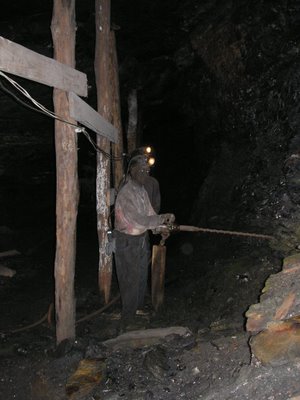We don hardhats and coats and ride the cable car deep into the cold abandoned anthracite mine near Scranton, Pennsylvania.
Coal is ranked in the U.S. from highest to lowest quality as anthracite, bituminous, subbituminous, and lignite. Recoverable reserves are estimated at about 275 billion tons, enough for about 200 years at the current rate of consumption. The cleanest and hottest burning coal is anthracite. This makes up 1.5% of the reserve and is located almost entirely in northeastern Pennsylvania.

Anthracite was formed during the Carboniferous geologic period from about 250 to 400 million years ago when Pennsylvania was covered with steaming swamps. The organic carbon was eventually thrust deep underground, morphed into anthracite by heat and pressure and then rose again in veins near to the surface by up thrust layers of rock. Commercial anthracite mining began in 1775.

In mining a seam of underground anthracite, it is necessary to leave a series of 20 by 60 foot pillars to help prevent collapse of the ceiling. Most of the available coal is left in place in these pillars to prevent roof collapse. Beams are placed between floor and ceiling, not to hold up the roof, but to provide cracking noises prior to a ceiling collapse. “When the beams start a-talking, you’d better be a-walking.”
Canaries were placed near the ceiling provided a warning of dangerous methane gas buildup. Rats collapsing on the mine floor indicated a dangerous carbon dioxide level (Black Damp). Eventually these biological warning devices were replaced with the Humpfries’ lamp.
An injured miner was placed in a wagon and left in his company provided home on the kitchen table. This was the extent of company medical benefits. A dead miner was simply left on the front porch and the widow was given three days to vacate. So much for the death benefits.
Children were eligible to begin work in the mines at age six. They worked the “breakers”, pulling out chunks of rock from the mined material as it was crushed. For this they earned $.06 per hour. At age 12, any surviving children could be promoted to operating 600 pound underground “airlock” doors needed for the ventilation system or they could also learn to lead mules pulling coal carts though the mine. The pay for this underground work was $.11 per hour. At age 21 you could become a miner earning about $1.50 for dynamiting and loading four tons of coal on a cart.. When “black lung” eventually prevented further hard labor, the miner could go back to work on the “breakers” at $.06 per hour. This was called the “Circle of the Miner”. Life expectancy was 42.
Payment was in Company script, which could be spent in the Company store. Those who were indebted to the Company could not leave the mining town. In 1902 the Unions began to prevent some of the worst exploitation. However, over 30,000 miners are thought to have died in mining operations since anthracite mining began. Employment in deep coal mining dropped from 180,000 in 1914 to 700 in 1987.
In 1930, the mules were replaced by an “electric donkey”. This was powered by a bare electric cable charged with 440 volts of DC power suspended about five feet off the mine floor. Touching this cable in the wet mine was another way to die quickly. Eventually, the unreliable burning dynamite fuses were replaced with electrically fused blasting caps, which reduced the death rate from blasting accidents.
Anthracite mining is expensive and has declined steadily in favor of the cheaper strip-mining of bituminous coal further west. Anthracite is very hard and shiny. It can be rubbed without discoloring one’s skin. A large chunk is surprisingly light. A very small chunk is available in the mine gift shop for $5.
Pictures of the Lackawanna Mine:

No comments:
Post a Comment